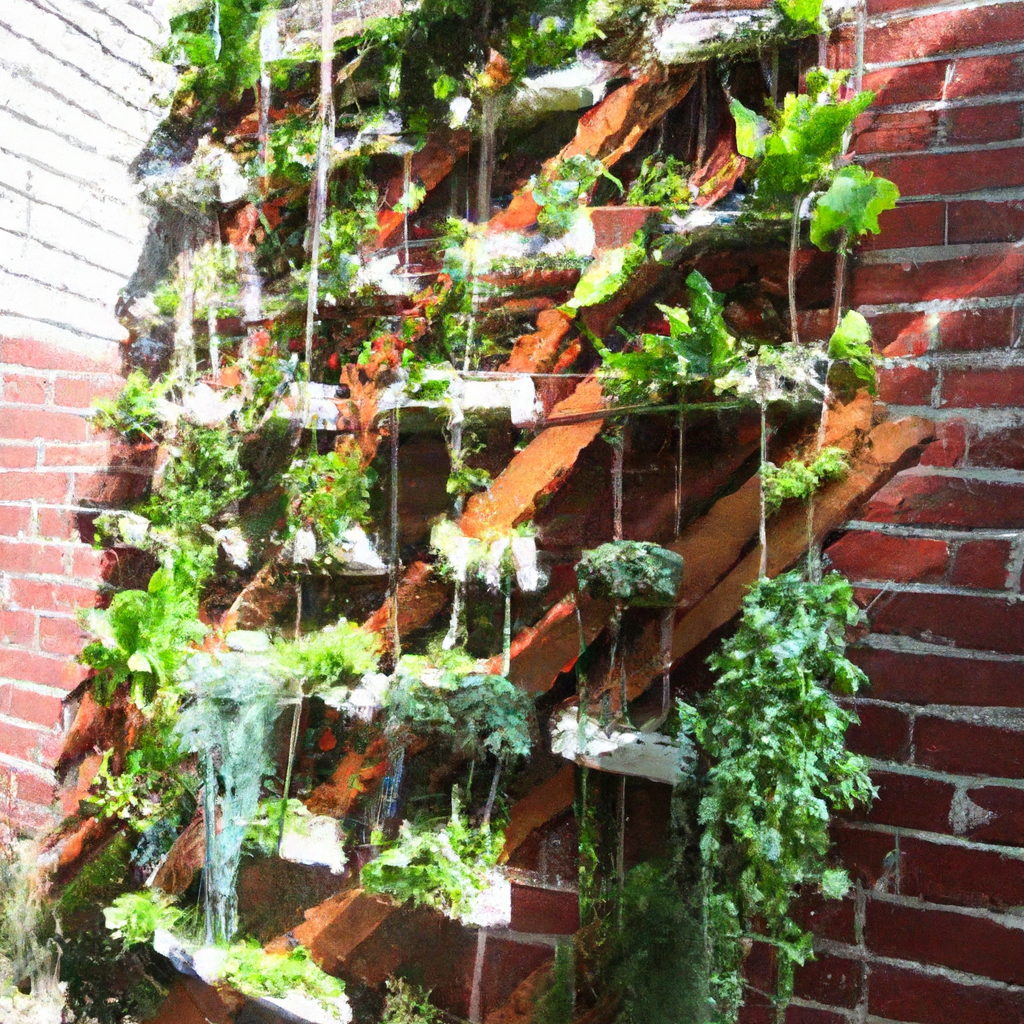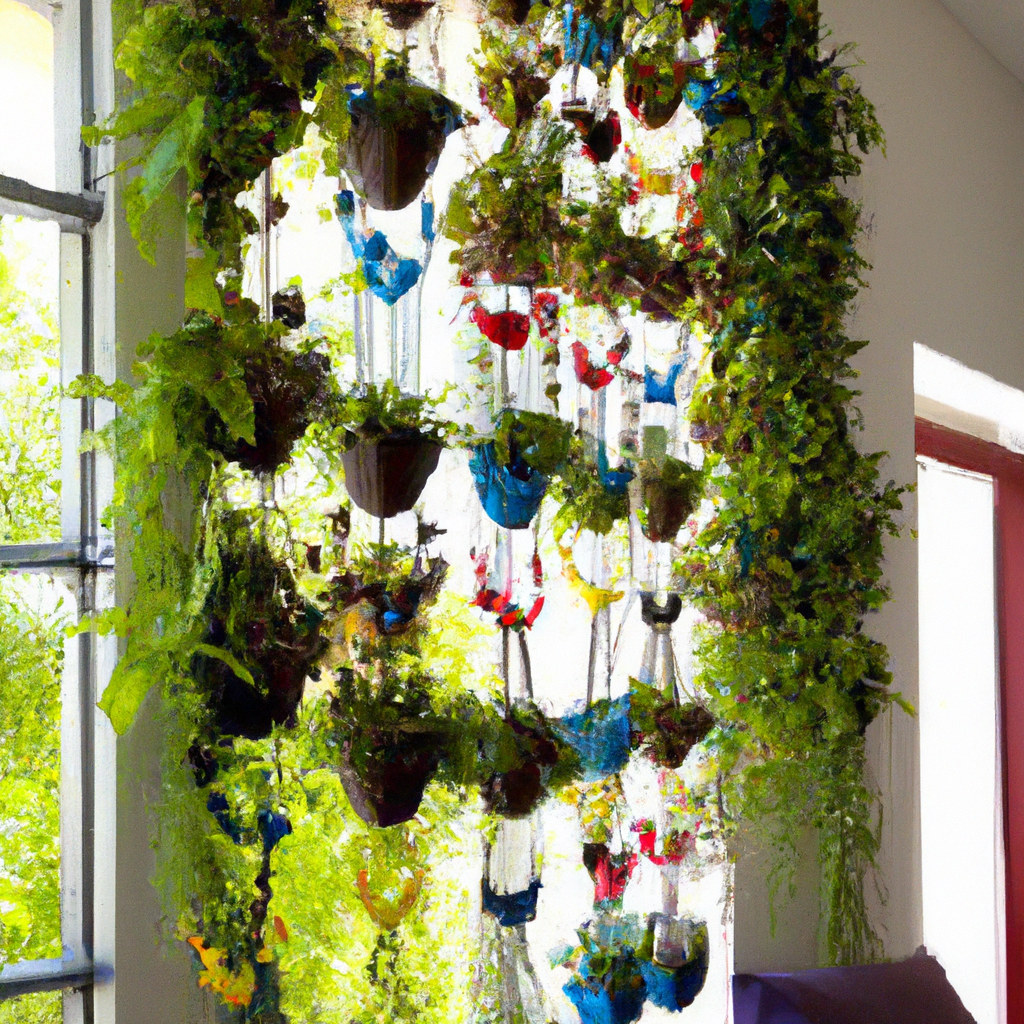
Imagine transforming your dull outdoor space into a vibrant and lush oasis with just a few simple steps. In this article, you will discover 10 ingenious ideas for DIY vertical gardens that will breathe life into even the smallest of spaces. From repurposed pallets to hanging mason jars, these creative designs will not only enhance the aesthetic appeal of your garden but also maximize your green space. Get ready to unleash your inner gardener and create a stunning vertical garden that will leave your friends and neighbors green with envy!

Hanging Shoe Organizer Vertical Garden
Materials needed
To create a hanging shoe organizer vertical garden, you will need the following materials:
- A hanging shoe organizer with clear pockets
- Potting soil
- Small plants or starter seeds
- A watering can or spray bottle
- Hooks or nails to hang the shoe organizer
Steps to create
- Choose a suitable location for your vertical garden. It could be a wall, a fence, or even the side of your house.
- Attach the hooks or nails to the chosen location, making sure they are sturdy enough to hold the weight of the shoe organizer.
- Fill each pocket of the shoe organizer with potting soil, leaving a small gap at the top.
- Plant your desired plants or seeds in each pocket, following the instructions for proper planting depth and spacing.
- Water the plants gently using a watering can or spray bottle. Ensure that the soil is evenly moist.
- Hang the shoe organizer on the hooks or nails, making sure it is secure and level.
- Maintain your vertical garden by regularly watering the plants, ensuring they receive enough sunlight, and fertilizing as needed.
Benefits of this idea
Creating a vertical garden using a hanging shoe organizer has several advantages. Firstly, it is a cost-effective solution that utilizes a commonly available item. The clear pockets of the shoe organizer allow for easy visibility of each plant, making it convenient to tend to their individual needs. Additionally, a shoe organizer can accommodate a significant number of plants in a relatively small space, making it ideal for those with limited outdoor areas. This vertical garden option also minimizes the risk of pests and diseases, as the plants are elevated from the ground. Overall, the hanging shoe organizer vertical garden is a practical and visually appealing way to grow plants in a compact manner.
Pallet Vertical Garden
Materials needed
To create a pallet vertical garden, gather the following materials:
- A wooden pallet
- Landscape fabric or burlap
- Staple gun or nails
- Potting soil
- Small plants or starter seeds
- A watering can or hose
Steps to create
- Choose a suitable location for your pallet vertical garden, ensuring it receives adequate sunlight.
- Prepare the pallet by removing any unnecessary boards or nails. Sand down any rough edges to prevent potential injuries.
- Attach the landscape fabric or burlap to the back of the pallet, using a staple gun or nails. This will prevent the soil from falling through the gaps.
- Stand the pallet upright, with the fabric side facing towards you.
- Fill each row and compartment of the pallet with potting soil, ensuring it is evenly distributed.
- Plant your desired plants or seeds in the soil, following the recommended planting depth and spacing.
- Water the plants thoroughly, making sure the soil is moist but not waterlogged.
- Allow the pallet vertical garden to fully establish before securing it to a wall or fence for added stability if desired.
Benefits of this idea
Building a vertical garden using a pallet offers numerous benefits. Firstly, it repurposes an otherwise discarded item, promoting sustainability and reducing waste. Pallets are readily available and can be obtained at little to no cost. The multiple rows and compartments of a pallet provide ample space to grow a variety of plants, making it perfect for herb gardens, small flowers, and even some vegetables. The vertical garden structure helps maximize the limited space in urban environments, allowing individuals to grow their own food or add greenery to their surroundings. Additionally, the pallet’s natural and rustic aesthetic adds a unique touch to any outdoor or indoor space.

Gutter Vertical Garden
Materials needed
To create a gutter vertical garden, gather the following materials:
- Rain gutters of desired length
- End caps for the gutters
- T-connectors (optional)
- Mounting brackets or hooks
- Potting soil
- Small plants or starter seeds
- A watering can or hose
Steps to create
- Measure and cut the rain gutter to the desired length using a saw or specialized cutter.
- Attach the end caps to both ends of the gutter to prevent soil and water from escaping.
- If desired, connect multiple gutters together using T-connectors for an extended vertical garden.
- Secure the gutters to a wall, fence, or balcony railing using mounting brackets or hooks. Ensure they are level and firmly attached.
- Fill the gutters with potting soil, making sure it is evenly spread.
- Plant your desired plants or seeds in the soil, following the recommended planting depth and spacing.
- Water the plants thoroughly, allowing excess water to drain out of the bottom of the gutters.
- Regularly maintain the gutter vertical garden by watering the plants and inspecting for any signs of pests or diseases.
Benefits of this idea
Opting for a gutter vertical garden presents several advantages. Firstly, it allows for efficient use of vertical space, particularly in urban environments where limited ground space is available. Gutters are lightweight and easily customizable to fit different lengths and layouts, making them adaptable to various outdoor or indoor settings. This vertical gardening option also provides good drainage, preventing waterlogging and potential root rot. Additionally, the gutters’ narrow width promotes a vertical growth habit for the plants, resulting in an aesthetically pleasing display. Overall, the gutter vertical garden offers a practical and visually appealing way to cultivate a variety of plants in constrained spaces.
Vertical Succulent Garden
Materials needed
To create a vertical succulent garden, gather the following materials:
- A wooden frame or container with multiple compartments
- Succulent potting soil or a well-draining soil mix
- Small succulent plants or cuttings
- A watering can or spray bottle
Steps to create
- Prepare the wooden frame or container by ensuring it is clean and free from any debris.
- Fill each compartment of the frame or container with succulent potting soil or a well-draining soil mix.
- Carefully plant small succulent plants or cuttings in each compartment, ensuring they are evenly spaced.
- Water the succulents gently, making sure the soil is slightly moist and allowing any excess water to drain.
- Place the vertical succulent garden in a location that receives bright, indirect sunlight.
- Monitor the moisture level of the soil regularly and water the succulents as needed. Remember to avoid overwatering, as succulents prefer drier conditions.
- As the succulents grow, maintain the garden by pruning any dead or overgrown parts to encourage new growth and ensure a tidy appearance.
Benefits of this idea
Creating a vertical succulent garden offers several advantages. Succulents are known for their low maintenance requirements, making them ideal for those with limited time or gardening experience. Their ability to store water in their leaves allows them to thrive in drier conditions, reducing the need for frequent watering. A vertical succulent garden adds a unique and visually appealing element to any space, be it indoors or outdoors. The compact nature of the garden makes it suitable for small areas, such as balconies, kitchen countertops, or even living room walls. Furthermore, succulents come in a wide range of colors and textures, providing endless possibilities for creating a striking and personalized design.

Recycled Container Vertical Garden
Materials needed
To create a recycled container vertical garden, gather the following materials:
- A variety of recycled containers, such as plastic bottles, cans, or jars
- Scissors or a craft knife
- Potting soil
- Small plants or seeds
- A watering can or hose
Steps to create
- Clean and prepare the recycled containers by removing any labels or remnants of their previous contents.
- Using scissors or a craft knife, create small holes or slits in the containers to allow for drainage.
- Fill each container with potting soil, leaving enough space at the top for planting the desired plants or seeds.
- Plant small plants or seeds in each container, ensuring they have enough room to grow.
- Water the plants thoroughly, allowing the excess water to drain out of the bottom of the containers.
- Arrange the recycled containers in a vertical manner, using hooks, a wooden frame, or a trellis to secure them in place.
- Regularly care for the vertical garden by watering the plants as needed and providing sufficient sunlight for their growth.
- Over time, monitor the plants’ progress and make any necessary adjustments to ensure proper growth and aesthetic appeal.
Benefits of this idea
Creating a vertical garden using recycled containers offers numerous benefits. Firstly, it promotes sustainability and waste reduction by repurposing items that would otherwise end up in landfills. By using a variety of container shapes and sizes, you can create a visually interesting and unique vertical garden design. This DIY approach allows for creativity and personalization, making it a fun project for individuals of all ages. Furthermore, a recycled container vertical garden is easily adaptable to different spaces, whether it be a balcony, a fence, or an indoor wall. The low cost and accessibility of materials make it an affordable option for those on a tight budget. Overall, this idea showcases the potential of transforming everyday objects into beautiful and functional vertical gardens.
Vertical Herb Garden
Materials needed
To create a vertical herb garden, gather the following materials:
- Wooden or metal wall planter
- Potting soil or an herb-growing mix
- Herb plants or seeds
- Watering can or hose
- Hooks or nails to hang the planter (if necessary)
Steps to create
- Choose a suitable location for your vertical herb garden, ensuring it receives sufficient sunlight and is easily accessible for harvesting.
- Install hooks or nails on the wall or fence where you plan to hang the wall planter.
- Fill the planter with potting soil or an herb-growing mix, ensuring it is well-draining and nutrient-rich.
- Plant your desired herb plants or seeds in the planter, following the recommended spacing and depth for each herb.
- Water the herbs thoroughly, ensuring that the soil is evenly moist but not waterlogged.
- Hang the wall planter on the hooks or nails, ensuring it is secure and level.
- Monitor and maintain the herbs by regularly watering, harvesting, and providing appropriate fertilizer if necessary.
- Enjoy fresh herbs for culinary purposes or as decorative plants in your vertical herb garden.
Benefits of this idea
Creating a vertical herb garden brings numerous benefits for both cooking enthusiasts and plant lovers. It allows you to have fresh, homegrown herbs easily accessible for culinary uses. By growing herbs vertically, you maximize the use of vertical space, making it an excellent option for those with limited outdoor areas. The vertical herb garden adds visual interest to any space and can be a focal point with its vibrant colors and fragrant scents. Growing herbs also promotes sustainability and reduces costs, as you can harvest as needed rather than buying pre-packaged herbs from the store. Additionally, herbs are relatively low-maintenance and require minimal space, making this idea achievable for beginners and experienced gardeners alike.

Mason Jar Vertical Garden
Materials needed
To create a mason jar vertical garden, gather the following materials:
- Mason jars or other glass containers
- Hanging materials (e.g., twine, wire, or hooks)
- Potting soil
- Small plants or seeds
- A watering can or spray bottle
Steps to create
- Prepare the mason jars by cleaning and ensuring they are free from any cracks or damage.
- If using twine or wire as the hanging material, cut several pieces to your desired length.
- Attach the hanging materials around the neck of each mason jar, ensuring they are securely fastened.
- Fill each mason jar with potting soil, leaving enough space at the top for planting the desired plants or seeds.
- Plant small plants or seeds in each mason jar, making sure they have enough room to grow.
- Water the plants gently, ensuring the soil is evenly moist but not saturated.
- Hang the mason jars in a vertical arrangement, allowing them to receive adequate sunlight for growth.
- Regularly care for the vertical garden by monitoring the moisture level of the soil and watering accordingly.
- As the plants grow, adjust the positioning of the mason jars to ensure proper spacing and an aesthetically pleasing arrangement.
Benefits of this idea
Creating a mason jar vertical garden offers several advantages. In addition to being visually appealing, it adds a touch of rustic charm to any space. Mason jars are versatile and come in various sizes, allowing for different plant choices and arrangements. This DIY project is budget-friendly and easily customizable to fit your preferences and available space. The vertical arrangement maximizes the use of limited space, making it suitable for individuals with small balconies, porches, or windowsills. The transparency of the mason jars also allows you to easily monitor the root growth and soil moisture level. Overall, the mason jar vertical garden is a creative and sustainable way to bring greenery into your home or outdoor area.
Vertical Flower Tower
Materials needed
To create a vertical flower tower, gather the following materials:
- A flower tower planter or garden tower
- Potting soil
- Flowering plants or seeds
- A watering can or hose
Steps to create
- Select a suitable location for your vertical flower tower, ensuring it receives ample sunlight for the chosen flowering plants.
- Fill the flower tower planter with potting soil, ensuring it is well-packed and level.
- Plant your desired flowering plants or seeds in each designated opening or compartment of the flower tower, following the recommended planting depth and spacing.
- Water the flowers thoroughly, ensuring the soil is evenly moist but not waterlogged.
- Monitor the moisture level of the soil regularly and water as needed, taking into account the specific watering requirements of your chosen flowers.
- Place the vertical flower tower in the chosen location, ensuring it is stable and upright.
- Regularly care for the flowers by removing any dead blooms or weeds and providing appropriate fertilizer if necessary.
- Enjoy the vibrant and eye-catching display of flowers as they grow and bloom.
Benefits of this idea
Creating a vertical flower tower offers several benefits for flower enthusiasts and gardeners alike. Firstly, it provides a stunning and unique focal point in any outdoor space, such as a garden, patio, or balcony. The vertical arrangement of flowers adds a sense of height and dimension, making it visually appealing. Flower towers are easily customizable, allowing you to choose a variety of flowering plants in different colors, shapes, and sizes. Additionally, the compact nature of the tower allows you to maximize the use of limited space, making it suitable for urban gardens or small outdoor areas. Regularly tending to the flowers promotes a sense of relaxation and fulfillment, making it a rewarding gardening project.

Fence Vertical Garden
Materials needed
To create a fence vertical garden, gather the following materials:
- Fence or lattice panels
- Mounting brackets or hooks
- Planters or pots
- Potting soil
- Small plants or seeds
- A watering can or hose
Steps to create
- Measure and cut the fence or lattice panels to fit the desired height and width of your vertical garden.
- Install the mounting brackets or hooks on the fence, ensuring they are securely attached.
- Hang the fence or lattice panels on the mounting brackets or hooks, aligning them horizontally or vertically, depending on the desired design.
- Fill each planter or pot with potting soil, leaving enough space for planting the chosen plants or seeds.
- Plant small plants or seeds in each planter or pot, ensuring they have enough room to grow.
- Water the plants thoroughly, ensuring the soil is evenly moist but not waterlogged.
- Attach the planters or pots to the fence or lattice panels using hooks, zip ties, or wire, ensuring they are secure and level.
- Maintain the vertical garden by regularly monitoring the moisture level of the soil and watering accordingly. Prune any overgrown plants or dead parts to ensure healthy growth and an aesthetically pleasing appearance.
Benefits of this idea
Creating a fence vertical garden offers numerous benefits. Firstly, it utilizes the existing structure of a fence, promoting efficient use of space. It adds greenery and visual interest to any outdoor area, making it an aesthetically pleasing addition to a garden or backyard. The vertical arrangement of plants allows for a greater variety of plants to be grown in a smaller area, creating a diverse and vibrant display. Additionally, a fence vertical garden provides privacy and sound insulation, acting as a natural barrier. It also helps to improve air quality and reduce the urban heat island effect. Overall, this idea combines functionality and beauty, transforming a plain fence into a living and thriving vertical garden.
Vertical Vegetable Garden
Materials needed
To create a vertical vegetable garden, gather the following materials:
- Vertical gardening system or planters
- Potting soil
- Vegetable plants or seeds
- Trellis or stakes (if growing climbing vegetables)
- A watering can or hose
Steps to create
- Select a vertical gardening system or planters suitable for growing vegetables, ensuring they are sturdy and provide proper drainage.
- Fill the chosen containers with potting soil, leaving enough space at the top for planting the vegetable plants or seeds.
- Plant your desired vegetable plants or seeds in each container, following the recommended planting depth and spacing.
- If growing climbing vegetables such as tomatoes or cucumbers, install a trellis or stakes to support their growth.
- Water the vegetable plants thoroughly, ensuring the soil is evenly moist but not waterlogged.
- Place the vertical gardening system or planters in a location that receives ample sunlight for vegetable growth.
- Regularly monitor the moisture level of the soil and water the plants as needed, taking into account the specific watering requirements of each vegetable variety.
- Observe the growth of the vegetables and provide appropriate support or pruning as necessary to ensure healthy and productive plants.
Benefits of this idea
Creating a vertical vegetable garden offers several advantages for those interested in homegrown produce. Firstly, it enables individuals with limited outdoor space to grow their own vegetables, whether they have a small balcony or a small yard. The vertical arrangement maximizes the use of limited space, allowing for a greater variety of vegetables to be grown in a smaller area. Growing vegetables vertically also helps prevent pests and diseases, as the plants are elevated from the ground. Additionally, harvesting from a vertical garden is more convenient, as vegetables are at eye level and easily accessible. This idea promotes sustainability, self-sufficiency, and healthy eating habits, as individuals can enjoy organic, fresh vegetables right from their own vertical garden.
In conclusion, DIY vertical gardens offer a creative and practical solution for individuals with limited space or a desire to maximize their gardening potential. Whether you choose to create a hanging shoe organizer vertical garden, a pallet vertical garden, a gutter vertical garden, a vertical succulent garden, a recycled container vertical garden, a vertical herb garden, a mason jar vertical garden, a vertical flower tower, a fence vertical garden, or a vertical vegetable garden, each idea provides its unique benefits. These vertical gardens not only add beauty and greenery to any space but also promote sustainability, self-sufficiency, and a sense of fulfillment. So why not explore these creative ideas and start your own DIY vertical garden today? Happy gardening!







